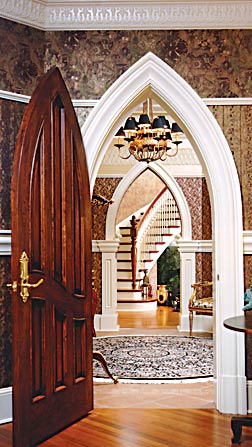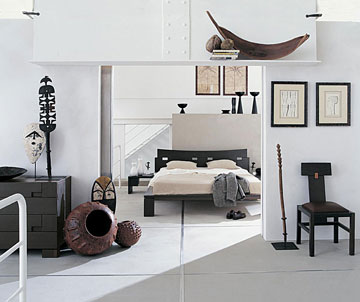Want to give your home character and charm? Add a little age with architectural antiques.
When it comes to introducing architectural antiques to a home, everything old is new again. Homeowners are looking to enliven their houses with antique details that are eye-catching, nostalgic, even comforting. There is a movement toward preserving and embracing past design to enhance the beauty of today’s homes. And architectural antiques can be the perfect way to bring added character and specific detail into a home.
Drama in the details
“I think people who are looking at historic homes in historic neighborhoods are looking for some drama. Those houses have built-in drama,” says Atlanta real-estate investor Michaela Graham. Over the years, he has bought and renovated about a dozen homes, adding architectural elements whether they match the home’s age or not. Sometimes going for perfection is costly. “I’m not a stickler for that,” she says. “It’s kind of hard to find something exactly in the same time period.” But that’s not a problem in her homes, “the bones and the historical stuff,” such as pocket doors, high ceilings, and trim are there from the start. Graham often likes to open up a home by taking down some walls, and she adds classic details such as columns.
One step at a time
There are myriad ways to add charming architectural elements. They don’t have to be expensive or done simultaneously, says interior designer Julie Silber of Metropolitan Artifacts. “It’s better to pace yourself. Certain things take time,” she says. “When you get started learning about architectural antiques, it takes you time to cultivate your eye, so you want to take things a few steps at a time.”
For example, you can dress up a door with antique knobs or pulls. Add iron urns to a front entry, bring in antique fire screens and fireplace mantels, or change out wooden spindles on a staircase with decorative iron, says. Antique door “jewelry” can start at $45 for knobs and go as high as $250, and from $800 to $1,500 for door pulls.
If you’re looking for apartments for rent in Ventura CA, consider the allure of architectural antiques to add character and charm to your new home. Embracing past designs and incorporating elements like pocket doors, high ceilings, and classic details such as columns can create a dramatic and nostalgic atmosphere, enhancing the overall beauty of your living space.
Elegance in the everyday
Architectural antiques can jazz up the most practical aspects of a home. For people interested in having antique-looking floors, there’s an expensive route, such as inlay. Then some alternatives offer the same type of look for less. “There are a lot of engineered products that do have an older look and feel to them,” says Michael Purser. The owner of the Rosebud Co. Examples in Atlanta of Purser’s floor restoration work can see at St. Luke’s Episcopal Church on Peachtree Street, Rhodes Hall of the Georgia Trust for Historic Preservation, and Bulloch Hall in Roswell.
Antique mantels are another excellent choice for adding old-fashioned elegance to your home. Available in a massive supply of shapes, sizes, and materials, mantels can easily stand alone as the only architectural antique element in a room. And most combine well with modern furniture and accessories. Fireplace mantels start at $750 and go up into the $10,000 range for a delicate antique mantel.
A Utilitarian home elevator
For a dramatic change in a larger home, an antique staircase may be just what you’re looking for. With a few adjustments to make sure it’s up to code and structurally sound, it can bring a piece of history into your 12 Spectacular Ideas for Wall Art in Any Room of Your Home. Even a utilitarian home elevator can become a work of art. “A lot of people who are building homes they wish to retire in are equipping them with ADA [Americans with Disabilities Act] standards. And that would include elevators,” Silber says. She suggests using an antique door for the façade of an elevator door to make it more attractive.
If you have a large entryway or a fence outside your house, an antique iron gate will give arriving guests a dramatic first impression of your home. For added outdoor appeal, try an antique streetlight in the yard or a pair of antique corbels above the front door.
Also, keep in mind that not every antique has to serve its original purpose. Bruce Cusano, the owner of Metropolitan Artifacts, often helps clients choose certain antique elements to repurposed in their homes. A set of antique corbels from Paris may become “legs” for a glass-top table, an asymmetrical iron door used as a headboard for a bed. A question-mark-shaped lamppost to light the streets of Chicago uses simply a fun, interesting conversation piece. “Always keep an open mind when you’re looking at any antique piece,” Cusano says.
Built-in beauty
Antiques bring into any home, but incorporating them into the architectural structure can be a little tricky. Many architectural antiques, such as doors and mantels, have to be just the right size to fit your home’s design. Limiting your options and making you work a little harder to find the perfect piece. But don’t give up—tons of antique elements made before dimensions in many homes were standardized. With all the different shapes and sizes out there, you may be able to track down just the right piece.
While most architectural antique companies are reluctant to modify antiques, they may alter a specific piece. To fit into your home as long as the piece’s original structure and design have not drastically changed. It’s also a good idea to have the antique company prepare each item to be installed. They should know what to do to make sure your new thing is ready to become part of your design.
Select antique elements
Of course, if you’re planning on building a new home, it will be much easier to incorporate any elements that you like. “With a new home, the sky’s the limit,” Cusano says. From the beginning, make sure to involve your architect, designer, and builder as you select antique elements. You’ll want to be sure that every piece you choose is structurally sound and can be incorporated easily into the home. For example, many antique doors are much more massive than standard ones, so the structures supporting them must bear the weight.
Don’t feel left out if you live in a smaller or rented space. Even if you can’t incorporate antiques into the home’s existing architecture, you can bring in a few less dramatic elements, like furniture and accessories. Lofts, which are so prevalent in Atlanta right now, are great for incorporating a few unique pieces. “Lofts are perfect for antiques,” Cusano says. “The high ceilings leave a lot of room for incorporating all of the large-scale pieces, like streetlights, mirrors, and chandeliers.”
Know what you want
Before incorporating architectural elements, homeowners need to prepare themselves with knowledge. It’s OK if you don’t know what you want right away. Renovation and antique professionals have more than enough photos, catalogs, and examples in their stores to help narrow the search. These days, many people are interested in the clean-lined Shaker style, says Donald Grabendike of SUN-DOR-CO, a custom door manufacturer. He says custom doors can cost from $500 to $20,000. Silber encourages her clients to take photos of the space they are interested in adding old details, so she has a better idea of what they’re working on.
Grabendike says he daunted when people bring him rough sketches they come up with on a dinner napkin. He says some people are surprised when they find out their dream door can be a reality. “Our limitations are only bound by your imagination. Send us your napkin,” he says, adding that customers should be as specific as they can. “We’ve had people say ‘we want something out of the ’30s.’ Well, the ’30s in Chicago were different from the ’30s in Atlanta,” Grabendike says. “There will be some subtle differences between the two.”
Handle with care
For work that requires professional installation, don’t be shy asking about the company’s credentials and verifying them as well, says Purser. After all, it’s your investment. “I think the main thing is looking at the person’s track record and where they’ve worked,” he says. Knowing their experience, expertise, and customer satisfaction is critical. Because (especially when dealing with floors) inconsistency throughout the home in style and quality is noticeable—sometimes embarrassingly so.
Often the homeowner will “end up living with it or having to explain the variation,” Purser says. Once the right person is on the job, both parties should keep communication healthy so that there will be no misunderstandings. And the professional has to know just what questions to ask to get to the heart of the client’s wishes.
“The No. 1 question is, ‘What do you not want to see?’” Purser says. He recalls someone telling him, “‘I don’t want a lot of red on my floor.’ What I finally figured out was they didn’t want their floors to look like red mahogany.” The stain they ended up choosing actually “had a ton of red in it,” but not in the way they disliked, he says. Also, measurements for items such as doors need to be exact, so it’s best to have a professional measure them.
For the many people infusing their homes with architectural elements, it’s a process of bringing or preserving refreshing elegance to their families. “Architectural antiques are not your grandparents’ antiques,” Silber says. “When done right, they don’t have to feel old and tired. They become art in your home. Architectural antiques should be looked at not necessarily as salvage, but as art investments.”
And remember, when you purchase any antique piece, make sure to ask about its background—every antique has a story to tell!




